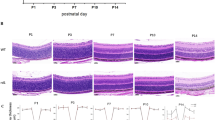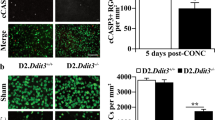Abstract
Mice of the DBA/2J strain spontaneously develop complex ocular abnormalities, including glaucomatous loss of retinal ganglion cells (RGC). In the present study ultrastructural features of retinal neurodegeneration in DBA/2J mice of different age (3, 6, 8 and 11 months) are described. By 3 months, RGC apoptosis characterized by electron-dense karioplasm and cytoplasm of ganglion cells was observed. The occurrence of apoptotic ganglion cells peaked at the age of 6 months. Past this age, necrosis characterized by swelling and electron-rare cytoplasm appeared to be the prevailing form of cell death. Müller glia activation increased with age, but there were no signs of leukocyte infiltration. At 8 and 11 months, signs of neoangiogenesis were found both at the ultrastructural level and in clinical examinations. In these older animals myelin-like bodies, most probably representing the intracellular aggregates of phospholipids in irreversibly injured cells, were also seen. Photoreceptor cells were not affected at any age. Our observations suggest that retinal degeneration in the DBA/2J mice does not involve recruitment of blood-borne inflammatory/phagocytosing cells, and that apoptosis is gradually replaced by necrosis as the predominant pathway of RGC death. Retinal degeneration in 3- to 11-month-old DBA/2J mice partially resembles human pigment dispersion syndrome and pigmentary glaucoma with characteristic anterior segment changes and elevation of intraocular pressure. However, neovasculogenesis and myelin-like bodies are observed during aging. Therefore, the DBA/2J model requires judicious interpretation as a glaucoma model.







Similar content being viewed by others
References
Bass LJ, Constantine VA (1988) Pigmentary dispersion syndrome and suspected low tension pigmentary glaucoma. J Am Optom Assoc 59:630–634
Campbell DG, Schertzer RM (1995) Pathophysiology of pigment dispersion syndrome and pigmentary glaucoma. Curr Opin Ophthalmol 6:96–101
Chang B, Smith RS, Hawes NL, Anderson MG, Zabaleta A, Savinova O, Roderick TH, Heckenlively JR, Davisson MT, John SW (1999) Interacting loci cause severe iris atrophy and glaucoma in DBA/2J mice. Nat Genet 21:405–409
Cotran RS, Kumar V, Collins T (1995) Robbins pathologic basis of disease, 6th edn. Chapter 1. Cellular injury and cell death. Saunders, New York, pp 1–30
Fauser S, Luberichs J, Schuttauf F (2002) Genetic animal models for retinal degeneration. Surv Ophthalmol 47:357–367
Francke M, Makarov F, Kacza J, Seeger J, Wendt S, Gartner U, Faude F, Wiedemann P, Reichenbach A (2001) Retinal pigment epithelium melanin granules are phagocytozed by Müller glial cells in experimental retinal detachment. J Neurocytol 30:131–136
Garcia-Valenzuela E, Sharma SC (1999) Laminar restriction of retinal macrophagic response to optic nerve axotomy in the rat. J Neurobiol 40:55–66
Garcia-Valenzuela E, Gorczyca W, Darzynkiewicz Z (1994) Apoptosis in adult retinal ganglion cells after axotomy. J Neurobiol 25:431–437
Garcia-Valenzuela E, Shareef S, Walsh J, Sharma SC (1995) Programmed cell death of retinal ganglion cells during experimental glaucoma. Exp Eye Res 61:33–44
Gelatt KN, Brooks DE, Samuelson DA (1998) Comparative glaucomatology. I. The spontaneous glaucomas. J Glaucoma 7:187–201
Gil D, Spalding T, Kharlamb A, Skjaerbaek N, Uldam A, Trotter C, Li D, WoldeMussie E, Wheeler L, Brann M (2001) Exploring the potential for subtype-selective muscarinic agonists in glaucoma. Life Sci 68:2601–2604
Goto W, Ota T, Morikawa N, Otori Y, Hara H, Kawaru K, Miyawaki M, Tano Y (2002) Protective effects of timolol against the neuronal damage induced by glutamate and ischemia in the rat retina. Brain Res 958:10–19
Hanninen VA, Pantcheva MB, Freeman EE, Poulin NR, Grosskreutz CL (2002) Activation of caspase 9 in a rat model of experimental glaucoma. Curr Eye Res 25:389–395
Hawes NL, Smith RS, Chang B, Davisson M, Heckenlively JR, John SW (1999) Mouse fundus photography and angiography: a catalogue of normal and mutant phenotypes. Mol Vis 5:22
Ishida S, Usui T, Yamashiro K, Kaji Y, Amano S, Ogura Y, Hida T, Oguchi Y, Ambati J, Miller JW, Gragoudas ES, Ng Y-S, D’Amore PA, Shima DT, Adams AP (2003) VEGF164-mediated inflammation is required for pathological, but not physiological, ischemia-induced retinal neovascularization. J Exp Med 198:483–489
John SW, Smith RS, Savinova OV, Hawes NL, Chung B, Turnbull D, Davisson M, Roderick TH, Heckenlively JR (1998) Essential iris atrophy, pigment disperssion, and glaucoma in DBA/2J mice. Invest Ophthalmol Vis Sci 39:951–962
Kacza J, Vahlenkamp TW, Enbergs H, Richt JA, Germer A, Kuhrt H, Reichenbach A, Müller H, Herden C, Stahl T, Seeger J (2000) Neuron-glia interactions in the rat retina infected by Borna disease virus. Arch Virol 145:127–147
Kendell KR, Quigley HA, Kerrigan LA, Pease ME, Quigley EN (1995) Primary open-angle glaucoma is not associated with photoreceptor loss. Invest Ophthalmol Vis Sci 36:200–205
Kerrigan LA, Zack DJ, Quigley HA, Smith SD, Pease ME (1997) TUNEL-positive ganglion cells in human primary open-angle glaucoma. Arch Ophthalmol 115:1031–1035
Kremmer S, Kreuzfelder E, Klein R, Bontke N, Henneberg-Quester KB, Steuhl KP, Grosse-Wilde H (2001) Antiphosphatidylserine antibodies are elevated in normal tension glaucoma. Clin Exp Immunol 125:211–215
Lagreze WA, Knorle R, Bach M, Feuerstein TJ (1998) Memantine is neuroprotective in a rat model of pressure-induced retinal ischemia. Invest Ophthalmol Vis Sci 39:1063–1066
Levin LA (2001) Animal and culture models of glaucoma for studying neuroprotection. Eur J Ophthalmol 11 (Suppl 2):S23–S29
Mano T, Puro DG (1990) Phagocytosis by human retinal glial cells in culture. Invest Ophthalmol Vis Sci 31:1047–1055
McKinnon SJ, Lehman DM, Kerrigan-Baumrind LA, Merges CA, Pease ME, Kerrigan DF, Ransom NL, Tahzib NG, Reitsamer HA, Levkovitch-Verbin H, Quigley HA, Zack DJ (2002) Caspase activation and amyloid precursor protein cleavage in rat ocular hypertension. Invest Ophthalmol Vis Sci 43:1077–1087
Mittag TW, Danias J, Pohorenec G, Yuan HM, Burakgazi E, Chalmers-Redman R, Podos SM, Tatton WG (2000) Retinal damage after 3 to 4 months of elevated intraocular pressure in a rat glaucoma model. Invest Ophthalmol Vis Sci 41:3451–3459
Mo JS, Anderson MG, Gregory M, Smith RS, Savinova OV, Serreze DV, Ksander BR, Streilein JW, John SW (2003) By altering ocular immune privilege, bone marrow-derived cells pathogenically contribute to DBA/2J pigmentary glaucoma. J Exp Med 197:1335–1344
Naskar R, Wissing M, Thanos S (2002) Detection of early neuron degeneration and accompanying microglial responses in the retina of a rat model of glaucoma. Invest Ophthalmol Vis Sci 43:2962–2968
Nork TM, Ver Hoeve JM, Poulsen GL, Nickells RW, Davis MD, Weber AJ, Vaegan, Sarks SH, Lemley HL, Millecchia LL (2000) Swelling and loss of photoreceptors in chronic human and experimental glaucomas. 118:235–245
Okisaka S, Murakami A, Mizukawa A, Ito J (1997) Apoptosis in retinal ganglion cell decrease in human glaucomatous eyes. Jpn J Ophthalmol 41:84–88
Parnaik R, Raff MC, Scholes J (2000) Differences between the clearance of apoptotic cells by professional and non-professional phagocytes. Curr Biol 10:857–860
Quigley HA (1998) Neuronal death in glaucoma. Prog Retin Eye Res 18:39–57
Quigley HA (2001) Advances in glaucoma medication during the 1990s and their effects. J Glaucoma 10 (Suppl 1):71–72
Quigley HA, Nickells RW, Kerrigan LA, Pease ME, Thibault DJ, Zack DJ (1995) Retinal ganglion cell death in experimental glaucoma and after axotomy occurs by apoptosis. Invest Ophthalmol Vis Sci 36:774–786
Roque RS, Rosales AA, Jingjing L, Agarwal N, Al-Ubaidi MR (1999) Retina-derived microglial cells induce photoreceptor cell death in vitro. Brain Res 836:110–119
Savinova OV, Sugiyama F, Martin JE, Tomarev SI, Paigen BJ, Smith RS, John SWM (2001) Intraocular pressure in genetically distinct mice: an update and strain survey. BMC Genet 1:12
Schuettauf F, Quinto K, Naskar R, Zurakowski D (2002) Effects of anti-glaucoma medications on ganglion cell survival: the DBA/2J mouse model. Vision Res 42:2333–2337
Sheppard, LB, Shanklin, WM, Fox RR (1967) A comparison of the findings from the corneal epithelium of the normal and the buphthalmic rabbit eye. Trans Am Ophthalmol Soc 65:256–274
Spacek J (2000) Atlas of ultrastructural neurocytology, http://synapses.mcg.edu/atlas/7_3_5.stm
Stittsworth JD, Bu P, Richards MP, Perlman JI, Stubbs EB (2002) Intraocular pressure changes and retinal cell damage in a DBA/2J mouse model of glaucoma. Invest Ophthalmol Vis Sci 43:E-Abstract 4052
Tatton NA, Tezel G, Insolia SA, Nandor SA, Edward PD, Wax MB (2001) In situ detection of apoptosis in normal pressure glaucoma: a preliminary examination. Surv Ophthalmol 45 (Suppl 3):268–272
Uysal H, Cevik IU, Soylemezoglu F, Elibol B, Ozdemir YG, Evrenkaya T, Saygi S, Dalkara T (2003) Is the cell death in mesial temporal sclerosis apoptotic? Epilepsia 44:778–784
Wang RF, Serle JB, Gagliuso DJ, Podos SM (2000) Comparison of the ocular hypotensive effect of brimonidine, dorzolamide, latanoprost, or artificial tears added to timolol in glaucomatous monkey eyes. J Glaucoma 9:458–602
Wang X, Tay SS, Ng YK (2002) An electron microscopic study of neuronal degeneration and glial cell reaction in the retina of glaucomatous rats. Histol Histopathol 17:1043–1052
Wax MB, Tezel G, Edward PD (1998) Clinical and ocular histopathological findings in a patient with normal-pressure glaucoma. Arch Ophthalmol 116:993–1001
Williams RW, Strom RC, Rice DS, Goldowitz D (1996) Genetic and environmental control of variation in retinal ganglion cell number in mice. J Neurosci 16:7193–7205
Acknowledgements
This study was supported in part by the European Union under the Marie Curie Individual Fellowship to Dr. Robert Rejdak (contract number:QLK2-CT-2002-51562). Dr. Frank Schuettauf was supported by the Fortüne program (912-1-0) and the European Union (QLK6-CT-2001-00385). The authors thank Sandra Bernhard-Kurz for excellent technical assistance.
Author information
Authors and Affiliations
Corresponding author
Rights and permissions
About this article
Cite this article
Schuettauf, F., Rejdak, R., Walski, M. et al. Retinal neurodegeneration in the DBA/2J mouse—a model for ocular hypertension. Acta Neuropathol 107, 352–358 (2004). https://doi.org/10.1007/s00401-003-0816-9
Received:
Accepted:
Published:
Issue Date:
DOI: https://doi.org/10.1007/s00401-003-0816-9




